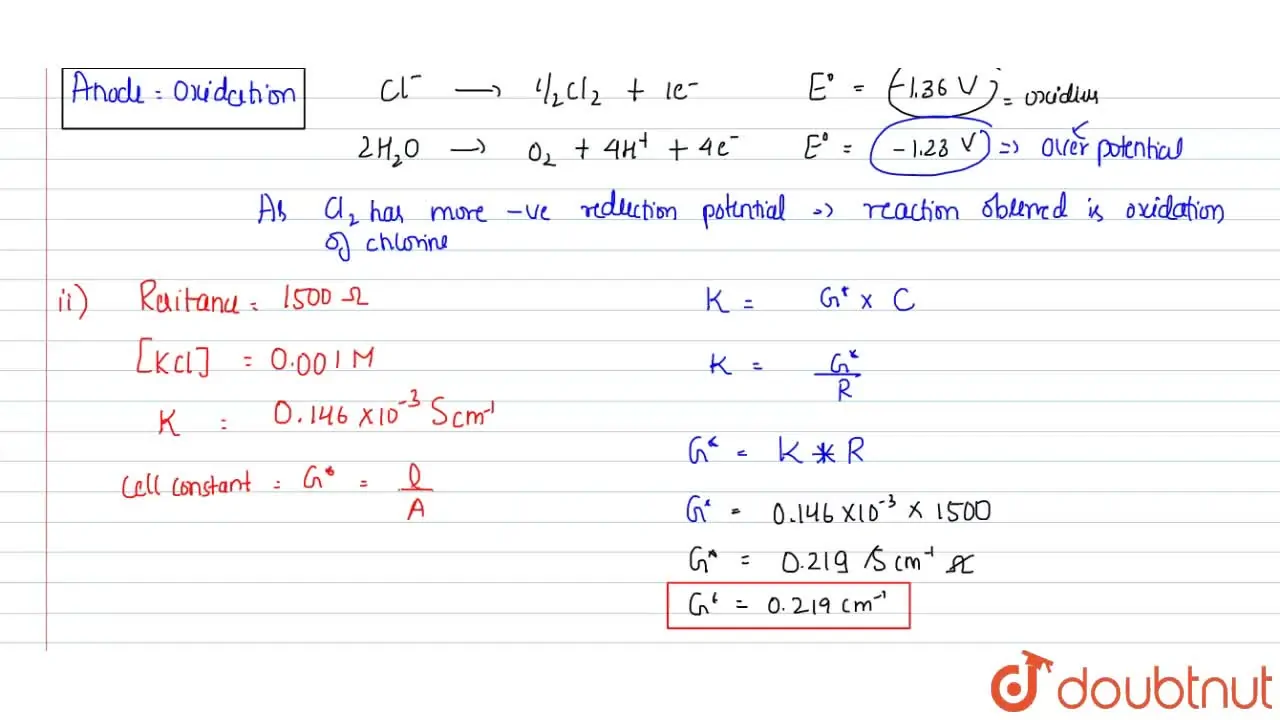(a) Explain why electrolysis of aqueous solution of NaCl gives H2 at cathode and Cl2 at anode. Write overall reaction.
(b) The resistancee of a conductivity cell containing 0.000M KCl solution at 298K is 1500Ω. Calculate the cell constant if conductivity of 0.001M KCl solution at 298K is 0.146×10−3Scm−1.Solution in Kannada
(a) Criteria: The Criteria is as follows: The substance which possess higher standard reduction potential is reduced first at the cathode. Whereas the substance which possesses lower reduction potential than water will get oxidised at the anode.
NaCl↔Na+(aq)+Cl−(aq)
2H2O(l)→O2(g)+4H++4e−
AT cathode:
2H2O(l)+2e−→H2+2OH−:E∘=−0.83V
Na+(aq)+e−→Na(s),E∘=−2.71V
Atanode: 12O2(g)+H2(g)→H2O,E∘=1.23V
2Cl−(aq)+2e−→Cl2(g),E∘=−1.36V
(b) R=1500ΩMolarity=0.001KCl
Cell const.=?
K (conductivity)=0.146×10−3Scm−1
Cell const.= Conductivity × Obs. resistance
=0.146×10−3×1500
=219×10−3cm−1
Related Playlists
- BOOK - OSWAAL PUBLICATIONCHAPTER - ELECTRO-CHEMISTRY EXERCISE - Topic - 3 ELECTROLYSIS , LAWS OF ELECTROLYSIS, BATTERIES, FUEL CELLS AND CORROSION (VERY SHORT ANSWER TYPE QUESTIONS)6videos
ELECTRO-CHEMISTRY
- BOOK - OSWAAL PUBLICATIONCHAPTER - ELECTRO-CHEMISTRY EXERCISE - Topic - 3 ELECTROLYSIS , LAWS OF ELECTROLYSIS, BATTERIES, FUEL CELLS AND CORROSION (SHORT ANSWER TYPE QUESTIONS)7videos
ELECTRO-CHEMISTRY
- BOOK - OSWAAL PUBLICATIONCHAPTER - ELECTRO-CHEMISTRY EXERCISE - Topic -2 REDOX REACTION, ELECTROCHEMICAL CELL, GALVANIC CELL, EMF OF CELL, STANDARD ELECTRODE POTENTIAL, NERNST EQUATION (LONG ANSWER TYPE QUESTION -I)7videos
ELECTRO-CHEMISTRY
- BOOK - OSWAAL PUBLICATIONCHAPTER - D - BLOCK ELEMENTS F - BLOCK ELEMENTS EXERCISE - TOPIC - 2 (F - BLOCK ELEMENT , LANTHANOIDS AND ACTINOIDS)(LONG ANSWER TYPES QUESTIONS)6videos
D - BLOCK ELEMENTS F - BLOCK ELEMENTS
- BOOK - OSWAAL PUBLICATIONCHAPTER - GENERAL PRINCIPLES AND PROCESSES OF ISOLATION OF ELEMENTS EXERCISE - TOPIC 2 (LONG ANSWER TYPE QUESTIONS-II)2videos
GENERAL PRINCIPLES AND PROCESSES OF ISOLATION OF ELEMENTS
Similar Questions
A galvanic cell after use is recharged by passing current through it. What type of cell is it? Give an example.
02:09View SolutionWhat type of cell is a lead storage battery? Write the anode and the cathode reactions and the overall cell reaction occurring in the use of a lead storage battery?
01:28View SolutionCalculate the e.m.f. of the cell in which the following reaction takes place.
Ni(s)+2Ag+(0.002M)→Ni2+(0.160M)+2Ag(s),Given E∘cell=1.05V01:48View SolutionCompare the chemistry with that of the lanthanoids with special reference to (i) electronic configuration (ii) atomic and ionic sizes (iii) oxidation state (iv) chemical reactivity .
05:31View SolutionPredict conditions under which Al might be expected to reduce MgO.
02:15View SolutionThe resistance of a conductivity cell contaning 0.001M KCl solution at 298K is 1500Omega . What is the cell constant if conductivity of 0.001M KCl solution at 298K is 0.146 xx 10^(-3)S cm^(-3) S cm^(-1) .
02:09View SolutionThe resistance of a conductivity cell containing 0.001M KCl solution at 298K is 1500 Omega . What is the cell constant ( in mm^(-1) ) if the conductivity of 0.001M KCl solution is 2xx10^(-3)Smm^(-1)
02:09View SolutionThe resistance of a conductivity cell containing 0.001 M KCl solution at 298K is 1500 Ω. What is the cell constant if conductivity of 0.001 M KCl solution at 298K is 0.146×10−3S cm−1?
04:02View Solution298K पर एक चालकता सेल जिसमे 0.001 M KCl विलयन है, का प्रतिरोध 1500Ω है। यदि 0.001 M KCl विलयन की चालकता 298K पर 0.146×10−3Scm−1 हो तो सेल स्थिरांक क्या है?
02:43View SolutionThe resistance of a conductivity cell containing 0.001M KCl solution at 298 K is 1500 Omega . What is the cell constant if conductivity of 0.001 M KCl solution at 298 K is 0.146xx10^(-3)S.cm^(-1) .
01:52View SolutionThe resistance of conductivity cell containing "0.001M KCl" solution at 298K is 1500Omega . What is the cell constant if the conductivity of "0.001M KCl" solution at 298K is 0.146 xx10^(-3)" S cm^(-1).
02:12View SolutionThe resistance of a conductivity cell containing "0.001M KCl" solution at 298 K is 1500 Omega . What is the cell constant if conductivity of "0.001M KCl" solution at 298 K is 0.146 xx 10^(-3)" S cm"^(-1) ?
View Solutionएक चालकता सेल जिसमे 0.001MKCl विलयम है का पर प्रतिरोध 1500ohm है यदि 0.001MKCl की चालकता 0.146×10−3Scm−1 हो तो सेल के सेल स्थिरांक की गणना कीजिए।
04:06View Solution0.001M KCI विलयन युक्त चालकता सेल का प्रतिरोध 298K पर 1500 ओम है। सेल स्थिरांक का निर्धारण कीजिये यदि 298 K पर 0.001M KCI विलयन की चालकता (विशिष्ट चालकत्व) का मान 0.146×10−3Scm−1 हो।
01:47View SolutionThe resistance of a conductivity cell containing 0.001M KCl solution at 298 K is 1500 Omega . What is the cell constant if conductivity of 0.001M KCl solution at 298 K is 0.146 xx 10^(-2) S cm^(-1) .
03:20View Solution


